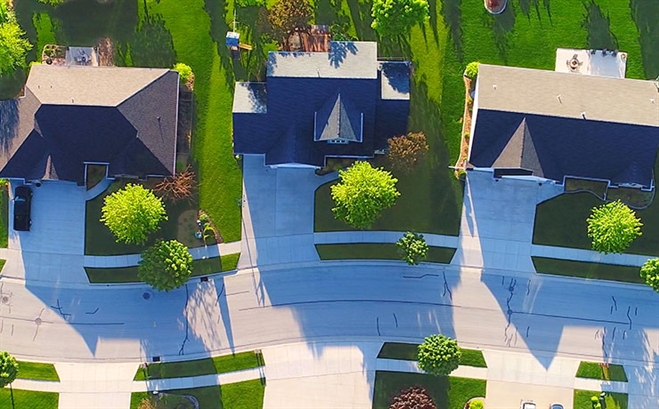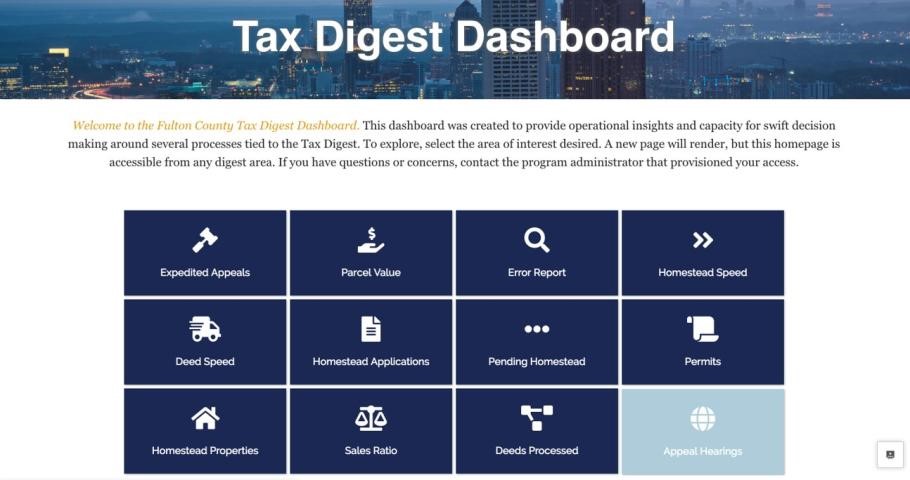One County's Journey to a Centralized Tax Dashboard
March 21, 2019 by Meredith Trimble

As budgets tighten, today’s appraisal and tax offices are challenged to accomplish more work with fewer resources. But it’s no longer enough to do more with less; today’s environment requires us to operate differently with less. The question becomes, how do you use what you already have more effectively for fair and equitable taxation? The benefits of integrating GIS data with computer-assisted mass appraisal (CAMA) systems are well known – it’s a proven synthesis. But what comes next?
In Fulton County, Georgia, officials faced cumbersome processes, fluctuating tax appraisals and rates, and community confusion. To overcome these hurdles, the county embarked on a project to create a centralized tax dashboard. The resulting customizable, cloud-based platform provides layered information to internal decision-makers through executive and management-level dashboards. It facilitates dashboarding of sensitive information through permissions. Users get custom alerts when data is updated, can track performance over time, and can view data as visualizations for intuitive analysis. The dashboard’s twenty key performance indicators, designed by Futon County based on day-to-day use, help everyone stay on track with appraisals and tax rate justification. In addition, near real-time data informs and validates process improvements for continued and sustainable success.

On February 26, Tyler Technologies’ Justin Bruce joined Dewayne Pinkney and Henry Brigham at the Urban and Regional Information Systems Association’s GIS/CAMA Conference in Portland, Oregon. Pinkney and Brigham provided attendees with insight into practical steps everyone can take to implement product integrations and dashboarding to help drive new operational efficiencies.
.jpg)
Think Beyond Technology
To truly reap the benefits of technology, leaders must drive shifts in organizational culture instead of merely adopting a new product or solution. People plus technology combined make the difference and empowering staff and creating buy-in for a data-enabled environment is critical. Pinkney described an organizational culture that is forward-looking and focused on innovation. A “First in Three” context for all strategic priorities set the stage for this successful project. “First in impact, first in service, and first in efficiency,” he explained.
To arrive at the dashboard, the county created a tax strategy team, affectionately known as the “Gang of 20,” that met every Friday morning. Together, attendees discussed everything they wanted from the project, from what data and queries would be of interest externally to what would best help the boots-on-the-ground staff in their daily work.
Immediate Impact, Future Flexibility
On the technical side, Brigham focused on the bottom line, explaining, “It’s all about saving time and putting the right information in the right place for the right people.” To do this, the project pulled the data from the county’s appraisal and tax system, Tyler’s iasWorld®, and integrated it with Tyler’s Socrata Connected Government Cloud for a seamless connection that surfaced immediate benefits:
- Near real-time data at managers’ fingertips
- Ability to track performance of cross-department tasks by combining Assessor data with the Clerk’s
- Automated data flow from the Assessor to the Auditor
- Freed-up analyst time to reallocate to higher-level, strategic tasks
- Ready subset or aggregated view of dashboard data that can be made publicly available with the click of a button
“Any great data set begins with a great query,” noted Brigham, who explained how automated queries flow seamlessly into the dashboard, saving him countless hours. Before the dashboard, he could spend an entire morning manually decoding some 70,000 lines to convert data into something his county commissioners could understand. Now, through the dashboard, commissioners have access to district-level information and can see live data, in charts or graphs, before or during meetings. The time saved has enabled Brigham to work on higher-level tasks. “This has turned me into more of a strategist now than an operator,” he said.
The dashboard also serves as a process improvement tool. The ability to graphically represent the data in a way that is accurate and easy-to-understand helps staff at all levels measure progress and see, at-a-glance, where work still needs to be done. The data is exportable, and users have a personalized, role-based view. Because all information is contained within the full data set, managers up the chain can view progress at any level from a city down to an individual appraiser. Anyone can sign onto the system and immediately see what must be done, whether in the office or in the field, without time-consuming research or waiting on reports.
The Value of a Strategic Vendor Partnership
The county’s back-end system integration along with its resulting benefits was fueled by a strategic, long-term partnership with a trusted technology vender. Working with a vendor whose solutions are fully integrated across platforms eliminates burdensome conversions and creates a core partnership with everyone working together on the same team across the organization.
Fulton County’s relationship with Tyler began in 1989 and has evolved as both partners successfully navigated innovation and adapted to keep pace with the digital world – from core, back-end systems to open data solutions and, now, operational dashboards. “Making data-driven decisions helps us improve our services as we strive to be effective, efficient, and fiscally sound,” said Sharon Whitmore, the county’s chief financial officer. “Partnering offers us the ability to tap into existing data and turns it into a tool that guides those decisions.”
Using modern technology to leverage the data that’s already at hand can streamline office operations and optimize the efficiency, productivity, and accuracy of property assessment and collection efforts.